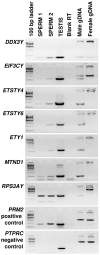Stallion sperm transcriptome comprises functionally coherent coding and regulatory RNAs as revealed by microarray analysis and RNA-seq
- PMID: 23409192
- PMCID: PMC3569414
- DOI: 10.1371/journal.pone.0056535
Stallion sperm transcriptome comprises functionally coherent coding and regulatory RNAs as revealed by microarray analysis and RNA-seq
Abstract
Mature mammalian sperm contain a complex population of RNAs some of which might regulate spermatogenesis while others probably play a role in fertilization and early development. Due to this limited knowledge, the biological functions of sperm RNAs remain enigmatic. Here we report the first characterization of the global transcriptome of the sperm of fertile stallions. The findings improved understanding of the biological significance of sperm RNAs which in turn will allow the discovery of sperm-based biomarkers for stallion fertility. The stallion sperm transcriptome was interrogated by analyzing sperm and testes RNA on a 21,000-element equine whole-genome oligoarray and by RNA-seq. Microarray analysis revealed 6,761 transcripts in the sperm, of which 165 were sperm-enriched, and 155 were differentially expressed between the sperm and testes. Next, 70 million raw reads were generated by RNA-seq of which 50% could be aligned with the horse reference genome. A total of 19,257 sequence tags were mapped to all horse chromosomes and the mitochondrial genome. The highest density of mapped transcripts was in gene-rich ECA11, 12 and 13, and the lowest in gene-poor ECA9 and X; 7 gene transcripts originated from ECAY. Structural annotation aligned sperm transcripts with 4,504 known horse and/or human genes, rRNAs and 82 miRNAs, whereas 13,354 sequence tags remained anonymous. The data were aligned with selected equine gene models to identify additional exons and splice variants. Gene Ontology annotations showed that sperm transcripts were associated with molecular processes (chemoattractant-activated signal transduction, ion transport) and cellular components (membranes and vesicles) related to known sperm functions at fertilization, while some messenger and micro RNAs might be critical for early development. The findings suggest that the rich repertoire of coding and non-coding RNAs in stallion sperm is not a random remnant from spermatogenesis in testes but a selectively retained and functionally coherent collection of RNAs.
Conflict of interest statement
Figures







Similar articles
-
The presence, role and clinical use of spermatozoal RNAs.Hum Reprod Update. 2013 Nov-Dec;19(6):604-24. doi: 10.1093/humupd/dmt031. Epub 2013 Jul 14. Hum Reprod Update. 2013. PMID: 23856356 Free PMC article. Review.
-
Chicken sperm transcriptome profiling by microarray analysis.Genome. 2016 Mar;59(3):185-96. doi: 10.1139/gen-2015-0106. Epub 2015 Dec 23. Genome. 2016. PMID: 26868024
-
The RNA content of human sperm reflects prior events in spermatogenesis and potential post-fertilization effects.Mol Hum Reprod. 2021 May 29;27(6):gaab035. doi: 10.1093/molehr/gaab035. Mol Hum Reprod. 2021. PMID: 33950245
-
Identification and quantification of coding and long non-coding RNAs in stallion spermatozoa separated by density.Andrology. 2020 Sep;8(5):1409-1418. doi: 10.1111/andr.12791. Epub 2020 Apr 17. Andrology. 2020. PMID: 32243084
-
All you need to know about sperm RNAs.Hum Reprod Update. 2021 Dec 21;28(1):67-91. doi: 10.1093/humupd/dmab034. Hum Reprod Update. 2021. PMID: 34624094 Review.
Cited by
-
AASRA: an anchor alignment-based small RNA annotation pipeline†.Biol Reprod. 2021 Jul 2;105(1):267-277. doi: 10.1093/biolre/ioab062. Biol Reprod. 2021. PMID: 33787835 Free PMC article.
-
Developmental RNA-Seq transcriptomics of haploid germ cells and spermatozoa uncovers novel pathways associated with teleost spermiogenesis.Sci Rep. 2022 Aug 19;12(1):14162. doi: 10.1038/s41598-022-18422-2. Sci Rep. 2022. PMID: 35986060 Free PMC article.
-
RNA Sequencing of Sperm from Healthy Cattle and Horses Reveals the Presence of a Large Bacterial Population.Curr Issues Mol Biol. 2024 Sep 19;46(9):10430-10443. doi: 10.3390/cimb46090620. Curr Issues Mol Biol. 2024. PMID: 39329972 Free PMC article.
-
PLCζ, WBP2NL and TNF-α expression in spermatozoa is associated with stallion fertility and seminal quality?Anim Reprod. 2024 Apr 12;21(1):e20230088. doi: 10.1590/1984-3143-AR2023-0088. eCollection 2024. Anim Reprod. 2024. PMID: 38628496 Free PMC article.
-
Sperm abnormality: Differential expression of microRNAs.J Assist Reprod Genet. 2025 Jun 30. doi: 10.1007/s10815-025-03562-x. Online ahead of print. J Assist Reprod Genet. 2025. PMID: 40587078 Review.
References
-
- Krawetz SA (2005) Paternal contribution: new insights and future challenges. Nat Rev Genet 6: 633–642. - PubMed
-
- Galeraud-Denis I, Lambard S, Carreau S (2007) Relationship between chromatin organization, mRNAs profile and human male gamete quality. Asian J Androl 9: 587–592. - PubMed
-
- Betlach CJ, Erickson RP (1973) A unique RNA species from maturing mouse spermatozoa. Nature 242: 114–115. - PubMed
-
- Paul J, Duerksen JD (1975) Chromatin-associated RNA content of heterochromatin and euchromatin. Mol Cell Biochem 9: 9–16. - PubMed
-
- Pessot CA, Brito M, Figueroa J, Concha, II, Yanez A, et al. (1989) Presence of RNA in the sperm nucleus. Biochem Biophys Res Commun 158: 272–278. - PubMed
Publication types
MeSH terms
Substances
LinkOut - more resources
Full Text Sources
Other Literature Sources
Molecular Biology Databases

